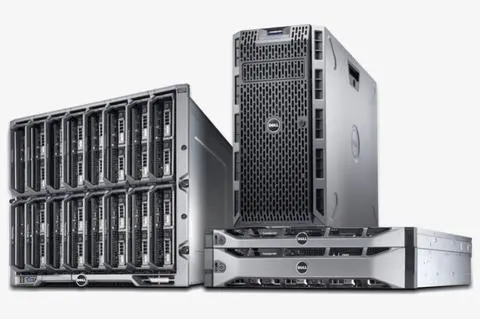How does a blade server differ from a traditional server?
Blade servers and traditional servers (e.g., rack servers or tower servers) differ fundamentally in design, architecture, and use cases. Below is a detailed comparison across key dimensions, highlighting their core distinctions.

1. Physical Form Factor & Density
Blade Servers:
Modular "blades" (thin, self-contained units) slide into a shared chassis (a large, standardized enclosure).
- High Density: A 7U chassis (e.g., Dell PowerEdge MX7000) can hold 8–16 blades, whereas 16 traditional 1U rack servers would require 16U of rack space.
Blades are compact, often lacking external ports (relying on the chassis for connectivity).
Traditional Servers:
Rack servers: Standalone units (1U–4U in height) mounted vertically in racks, with their own power supplies, network ports, and storage bays.
Tower servers: Desktop-like, freestanding units (similar to large PCs) designed for small offices.
Lower density: A full rack (42U) typically holds 10–40 rack servers, depending on their size.
2. Resource Sharing
Blade Servers:
Share critical infrastructure within the chassis:
Power supplies, cooling fans, and power distribution units (PDUs).
Network (Ethernet, InfiniBand) and storage (SAS, NVMe) connections via internal backplanes (eliminating the need for individual cables per blade).
Redundant components (e.g., dual power supplies) are shared across all blades, reducing redundancy costs.
Traditional Servers:
Each server is self-contained, with its own power supply, cooling, and ports.
Requires separate cabling for each server (e.g., network cables, power cords), leading to cable clutter in large deployments.
Redundancy (e.g., dual power supplies) must be added to each server, increasing per-unit costs.
3. Scalability
Blade Servers:
Rapid, incremental scaling: Adding capacity involves inserting a new blade into an empty chassis slot—no need to configure new power, cooling, or network connections.
Limited by chassis capacity: Once a chassis is full, scaling requires a new chassis (higher cost per incremental unit).
Traditional Servers:
Scaling requires adding entire new servers, each needing power, cooling, and network setup (slower and more labor-intensive).
More flexible for small-scale growth: Adding 1–2 rack servers is cheaper than buying a new blade chassis.
4. Management & Administration
Blade Servers:
Centralized management: Chassis-level tools (e.g., Dell OpenManage, HPE OneView) allow admins to monitor, configure, and update all blades from a single interface.
Simplified maintenance: Blades are hot-swappable (can be removed/inserted without powering down the chassis), reducing downtime.
Traditional Servers:
Decentralized management: Each server is managed individually or via tools that require separate configuration for each unit (e.g., remote management cards like Dell iDRAC).
Maintenance often requires powering down the server or accessing it physically (more downtime).
5. Cost Structure
Blade Servers:
Higher upfront costs: Chassis (with power/cooling) + blades = 30–50% more expensive than equivalent rack servers initially.
Lower long-term operational costs: Reduced power/cooling usage (20–30% savings) and lower cabling/maintenance expenses.
Traditional Servers:
Lower upfront costs: Individual rack/tower servers are cheaper to purchase initially.
Higher long-term costs: More power consumption, cable management, and labor for maintenance.
6. Flexibility & Customization
Blade Servers:
Proprietary and standardized: Blades only work with their vendor’s chassis (e.g., Dell blades in Dell chassis), creating vendor lock-in.
Limited hardware flexibility: Fixed form factors restrict upgrades (e.g., fewer PCIe slots, limited storage bays, or inability to add large GPUs).
Traditional Servers:
Vendor-agnostic: Mixing brands (e.g., Dell, HPE, Lenovo) in a rack is common.
Highly customizable: Support for more storage drives, PCIe expansion cards (e.g., GPUs, RAID controllers), and specialized hardware (e.g., high-speed network adapters).
7. Use Cases
| Blade Servers | Traditional Servers |
| Large data centers with standardized workloads (virtualization, cloud, web hosting). | Small businesses or remote offices (tower servers). |
| Environments prioritizing space efficiency and centralized management. | Workloads requiring custom hardware (e.g., AI with GPUs, high-performance computing). |
| Dynamic scaling needs (e.g., seasonal traffic spikes). | Small-scale deployments (fewer than 5 servers) where upfront cost matters. |
Key Takeaway
Blade servers optimize for density, efficiency, and centralized control, making them ideal for large, standardized deployments. Traditional servers prioritize flexibility, lower upfront costs, and customization, suiting small-scale or specialized workloads. The choice depends on scale, budget, and the need for hardware flexibility.
评论
发表评论